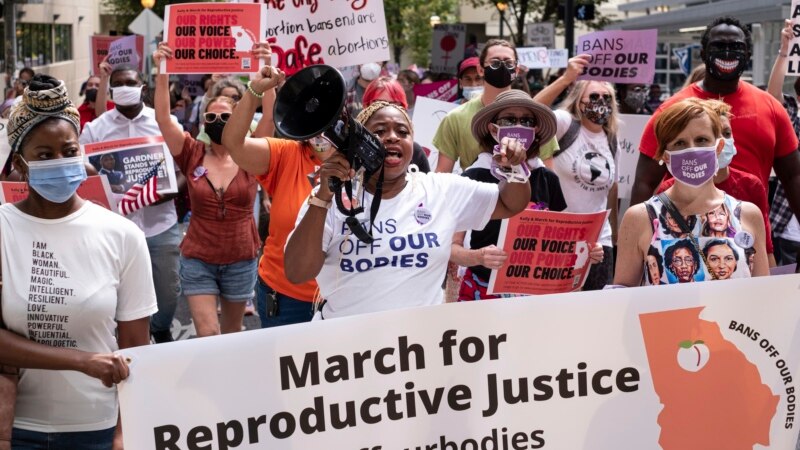
Last month’s U.S. Supreme Court decision eliminating a nationwide right to abortion will heavily impact minority and low-income women, leading to worse outcomes along socio-economic lines, according to researchers, reproductive rights groups and civil rights organizations.
“The Supreme Court decision will disproportionately harm women and children of color, those living on lower incomes, including immigrants,” National Urban League President Marc Morial told VOA. “Our organization will continue to fight for the reproductive rights of women.”
More than a dozen U.S. states have laws banning nearly all abortions that were activated when the Supreme Court overturned its 1973 decision that legalized abortion in the United States. Many of those state laws are being contested in court. Other states are expected to enact new abortion bans, potentially leaving women without access to the procedure in vast swaths of the country.
Several states with abortion bans tout social services and programs to help needy mothers. Anti-abortion groups say they, too, stand ready to help pregnant women of all races and economic conditions.
“Nearly 3,000 pregnancy centers across the country lovingly give hope and encouragement to expectant mothers and provide critical resources throughout pregnancy and after their child is born, typically at no charge,” said Marjorie Dannenfelser, president of Susan B. Anthony Pro-Life America, in a recent statement.
The group also supports Louisiana’s Women’s Right to Know Law. It mandates that state agencies provide information on abortion alternatives, assist women during and after pregnancy, and that adoptive parents in many cases pay the medical costs associated with carrying a woman’s child to term.
More pregnancy-related deaths
Even with such assistance, a recent study concluded that abortion bans would result in more deaths among Black women than any other racial group. The study, conducted last year by Duke University, estimated that pregnancy-related deaths among Blacks would increase by 33% in the years following an abortion ban, compared with a 21% increase for the overall population.
“By more women giving birth we can expect infant mortality to rise but it won’t be felt equally because of racial disparities,” said Lisa Harris, an obstetrician-gynecologist who teaches at the University of Michigan.
Even before the Supreme Court made abortion access a state-by-state matter, Native American, Alaska Native, Black and other minority women were two to three times as likely to die from a pregnancy-related cause than white women, according to the Centers for Disease Control and Prevention (CDC).
The Guttmacher Institute, a Washington-based research and policy organization that advocates reproductive health rights, calculates more than 900,000 legal abortions were performed in the U.S. in 2020.
Myriad factors go into the decision to seek the procedure, according to abortion rights defenders.
“An abortion is not something where it’s either make a choice to choose to be a parent or not to choose to be a parent,” said Oriaku Njoku, executive director of ARC-Southeast, a group that provides funding and logistical support for reproductive care based in Georgia, speaking on ABC News. “There’s so many things like access to food, access to a living wage, access to insurance, your race, your gender, your ability to make money for your family.”
Georgia example
Georgia is one of 33 U.S. states that ban the use of government Medicaid funds for abortions, putting a greater financial burden on low-income and minority women seeking the procedure. In 2019, Republican Governor Brian Kemp signed a bill banning most abortions in the state after six weeks of pregnancy.
Kemp recently defended the law while hailing resources available to pregnant women in Georgia.
“We have worked hard to increase supportive services for mothers and their children – before, during, and after birth,” Kemp said in a statement. He highlighted “expanding pregnancy and parental resources, extending health coverage to a full year for mothers after birth, improving our adoption system, and reforming foster care.”
In Indiana, meanwhile, Republican lawmakers have proposed allocating $58 million to increase services for pregnant women, including $30 million to help low-income families under the Medicaid program.
But abortion rights activists argue expanding social services is no substitute for maintaining a woman’s right to terminate a pregnancy. Both, they say, are needed.
“Improving access to health care, education and family planning are better ways to reduce unintended pregnancies than trying to restrict abortion,” said Njoku.
Biden administration responds
Responding to the Supreme Court decision overturning Roe v. Wade, President Joe Biden signed an executive order in early July boosting federal efforts to ensure women’s access to health care, including emergency medical services, family planning and contraception. The directive also seeks to protect women who travel across state lines for abortions as well as their access to medical abortions.
“We cannot allow an out-of-control Supreme Court … to take away freedoms and our personal autonomy,” Biden told reporters at the White House.
Anti-abortion groups remain mobilized as well.
“Our legal team will continue to file (legal) briefs as needed and advise lawmakers in all 50 states,” said Americans United for Life in a statement. “We are helping create over 400 pro-life bills in over 40 states and our legal experts are preparing to fight for the sanctity of human life in all 50 states.”
